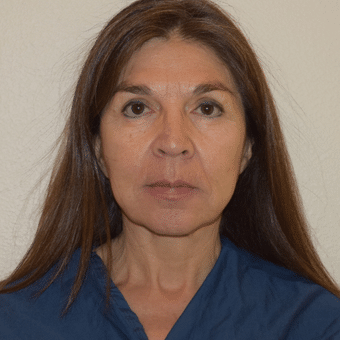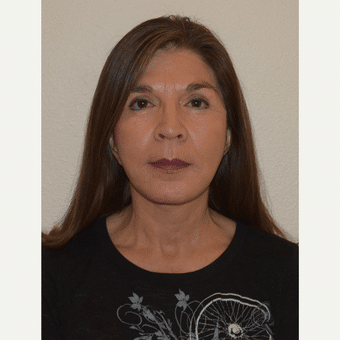
Dermal fillers such as Radiesse, Juvederm or Sculptra are a very popular option for short-term improvement in restoring three-dimensional facial projection. Facial implants however are a permanent option for correcting deficient facial volume without the need to undergo multiple and repeated injections over time. Furthermore, there is not a better substitute for a receded or “weak” chin than a chin implant.
Too commonly in facial aesthetic surgery, Surgeons concentrate on lifting and tightening the facial skin and in improving the skin’s appearance. Neglecting the mid facial region (cheeks) or chin during facial aesthetic restoration should not be overlooked.
Facial Implants
Facial implants are a permanent option for restoring volume and a youthful appearance to the face.
Dermal fillers such as Radiesse, Juvederm or Sculptra are a very popular option for short-term improvement in restoring three-dimensional facial projection. Facial implants however are a permanent option for correcting deficient facial volume without the need to undergo multiple and repeated injections over time. Furthermore, there is not a better substitute for a receded or “weak” chin than a chin implant.
Too commonly in facial aesthetic surgery, Surgeons concentrate on lifting and tightening the facial skin and in improving the skin’s appearance. Neglecting the mid facial region (cheeks) or chin during facial aesthetic restoration should not be overlooked.
FAQs About Facial Implants
Facial implants are specially shaped, biocompatible (coexisting with living tissue without causing harm), materials designed to enhance or augment the physical makeup of your face. Facial implants augment the three-dimensional structure of your face in order to achieve a more harmonious aesthetic appearance. The implants are offered in pre-formed nasal, chin and malar (cheek) shapes. Custom implants are also available if needed.
The most commonly used facial implant is a chin implant. When properly used, chin implants will bring balance to the face. Chin implants not only improve the chin and lower face but also bring a harmonious balance with the nose and midface. After inserting a chin implant, a large appearing nose with previously weak appearing chin will cause the nose to appear smaller and in better balance with the entire face. Midfacial implants known as Malar and Submalar implants are also commonly used to treat a flat midfacial appearance. Midface implants will lift the cheeks and establish a balance between the forehead, midface, lower face and neck.
The two most commonly used facial implant materials are silicone and ePTFE (expanded Polytetrafluoroethylene, aka Gortex). Both types of implants are quite suitable for facial implantation. Silicone implants are advantageous because of their malleability and ease of insertion. Silicone implants are also easy to remove if the need or desire arises. Expanded Polytetrafluoroethylene (ePTFE) acts like a mesh; it is used for implants during cosmetic and reconstructive surgery as it can be shaped quite easily and is porous so the tissue and bone can grow into it. ePTFE implants are advantageous for their “bone-like” properties. ePTFE implants have little malleability but because of their porous structure allow for tissue ingrowth and better integration into your existing facial framework.
Facial implants are used to add volume and symmetry to the face in order to achieve a more youthful and balanced appearance. Although the implant offers a permanent result, they can typically be easily removed if so desired.
Facial implants are considered a permanent solution to augmentation of the facial skeleton. Once properly placed, the implants should be considered as an extension of your normal anatomy. Certain situations however call for the removal of the implants. Infection, malposition, or dissatisfaction are reasons to remove the implants. Otherwise, facial implants can last a lifetime.
Candidates for facial implants include a variety of patients presenting with various facial aesthetic conditions. Younger individuals with facial skeletal deficiencies such as a weak or receded chin or flat mid facial appearance may benefit from augmentation of their facial contour through the use of facial implants. Older patients who are experiencing facial volume loss thorough the aging process are also good candidates for facial implants. Restoring lost facial volume due to aging of the mid face is a common reason to use facial implants. The type and size of facial implants best matched for you requires an evaluation of your goals and expectations along with your surgeons recommendation.
Typically facial implants remain secure within a meticulously developed pocket under the soft tissues of the face. Also, the vast majority of facial implants I place are secured with one or two fixation devices to the underlying bone. While malposition of implants can occur, this is not typical. ePTFE implants move less than silicone implants due to the physical structure of the ePTFE implant. ePTFE implants have a porous structure like a sponge or coral. This porous structure allows for your natural soft tissue to attach to and anchor the implant better than a smooth silicone implant.
While injectable fillers and facial implants are both used to enhance and augment the three –dimensional physical facial structure, there are distinct advantages and disadvantages to both treatments. Dermal fillers can be used in multiple facial planes or levels to achieve both facial volume restoration as well as fill in visible skin lines and wrinkles. Facial dermal fillers such as Radiesse, Sculptra, Restylane and Juvederm are substances designed to “inflate” areas of the face. Restylane or Juvederm are the primary and ideal mode of treatment to plump the lips or fill in hollowness under the eyes. There is not a permanent lip implant on the market that can rival the outcome of well-placed dermal filler. Dermal fillers are also used to add a greater amount of volume in the deeper facial tissues similar to how a permanent implant would “fill-in” the cheek or give a higher appearing cheekbone. However, there is not a better alternative for a weak or receded chin than a permanent chin implant. Dermal fillers are considered temporary or semi-permanent and therefore will last between 6-18 months. Facial implants in contrast are considered to be a permanent solution to facial volume deficiency and can last a lifetime. Dermal fillers are performed comfortably in the office setting and have little to no downtime after the treatment. Facial implants are a surgical treatment and require sedation or general anesthesia.
Facial implant procedures are typically performed at an accredited outpatient surgical facility. General anesthesia is commonly used for anesthesia to accomplish the procedure. Isolated chin implants may be inserted in an office-based setting using only local anesthesia.
Chin implants may be inserted through either an oral (mouth) incision or chin incision. It is my practice to insert chin implants through a small incision on the undersurface of the chin. While a small scar will result from this procedure, it is hidden under the chin. In addition, the chance of infection is reduced by avoiding contact of the implant with the oral cavity. Finally, the chance the implant shifts to a higher position is decreased by developing the implant pocket from below as opposed to above. Midfacial and mandibular implants are inserted through the oral cavity. A small incision is made in the mucosa in the “gutter” above the teeth on each side. The dissection is essentially bloodless for both of these techniques. Once the implants are in position, one or two small microscrews are used to fixate the implant and guard against significant movement.
The amount of time required to place facial implants varies between thirty and sixty minutes. Chin implants take the least amount of time to place since there is only one implant and the site of implantation is easiest to access. Mid-facial and mandibular implants take longer to place due to there being two sides as well as a slightly more challenging placement.
It is important that you be prepared for your postoperative recovery period. Complete written post-operative instructions will be provided prior to surgery. The day of surgery you will feel sleepy from the anesthesia. The discomfort experienced from facial implants is mild to moderate depending on the site of implantation. When you awaken from the anesthetic, a light compressive facial garment or bandage will be present. The bandage remains in place for the first 24-72 hours. The first follow-up appointment is within one week. For the first day or two you should eat a soft diet until your swelling and soreness resolve. Cool compresses applied intermittingly to the face are recommended for the first 48 hours after surgery. Ice bags should NEVER be used against the skin, as the area may be numb due to local anesthesia and swelling. Applying ice directly to numb skin may result in skin injury. Showering with warm water is allowed on the first post-operative day. If the implants were placed through an incision inside the mouth, oral rinsing will be completed four times per day. Pain medication and prophylactic antibiotics will be prescribed and should be taken as directed. Sleeping with the head elevated will help reduce post-operative swelling. No strenuous activity is allowed for two weeks following surgery. Ointment, applied over the sutures, will be used at least three times a day for the first week.
The decision to have facial implant surgery is personal and you’ll have to decide if the benefits will achieve your goals and if the risks and potential complications are acceptable. Your plastic surgeon will explain in detail the risks associated with surgery. You will be asked to sign consent forms to ensure that you fully understand the procedure you will undergo, the alternatives and the most likely risks and potential complications. Some of the risks include: Bleeding, infection, change in skin sensation, unfavorable scarring, shifting of the implants and need for additional surgery. Other potential risks include damage to nerves or blood vessels, allergies to tape or topical ointment, excessive scar tissue, or skin contour irregularities.
See these before and after images to get an idea of the success other patients have found with Dr. Mitchell and his team.
Before

After

Age Gracefully: The Benefits of Non-Surgical Anti-Aging Treatments
Aging is a natural process that brings wisdom and experience, but it also brings changes to our skin and appearance that many of us would like to manage gracefully. For those who prefer to avoid surgery, there are numerous non-invasive treatments available that can help maintain a youthful appearance. These treatments offer effective solutions with […]
Read MoreTestimonials
What People are Saying
Dr. Mitchell's patients love him and his team and are always incredibly happy with their results!
A skilled personable artist with integrity. I had Radiesse done on a few occassions with Dr. Mitchell with great results. He will recommend what he thinks will help the patient ...
Excellent doctor! Had Blepharoplasty done and he did an amazing job!! Perfect work. He is also very kind and takes his time to listen to your needs. He is also ...
Recently had liposuction done by Dr. Mitchell on a problem area in my mid section and I couldn't be more happy. The staff was great and the results are amazing. ...
